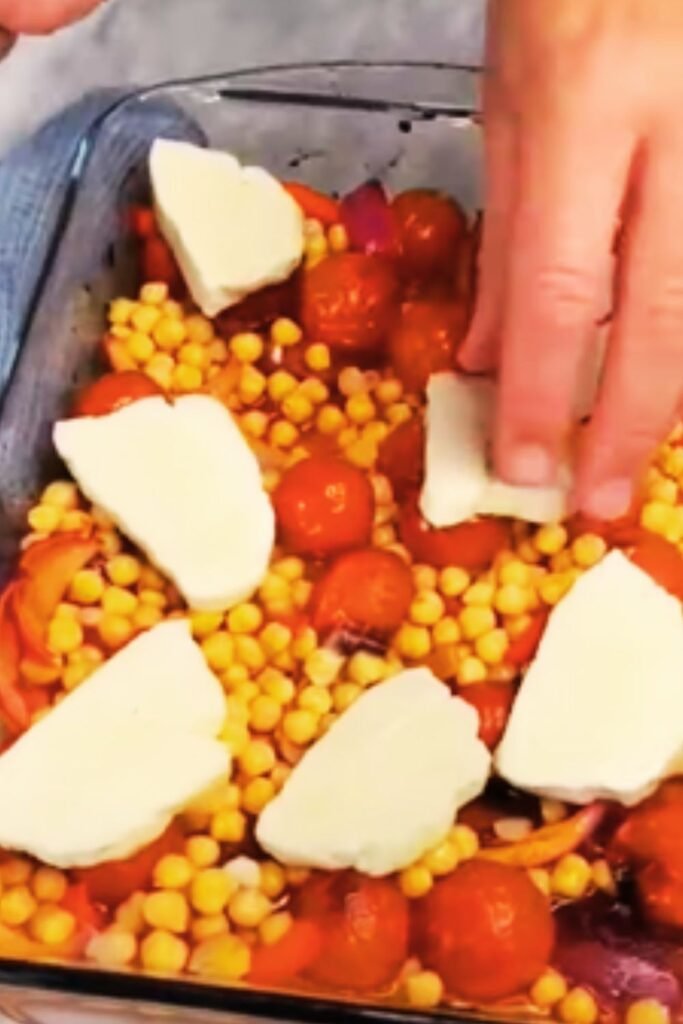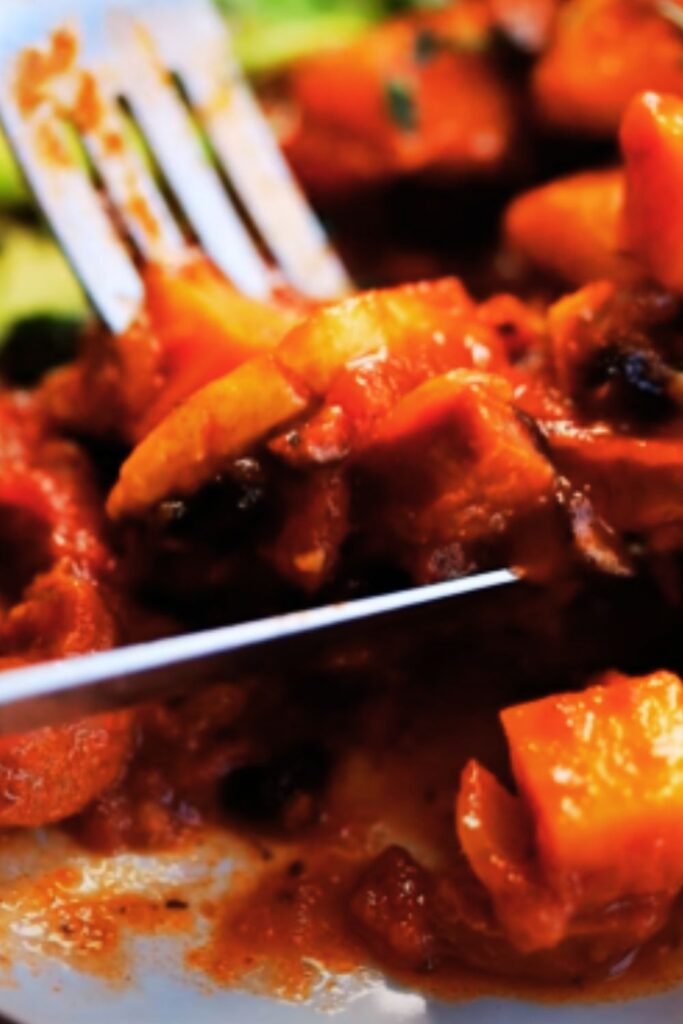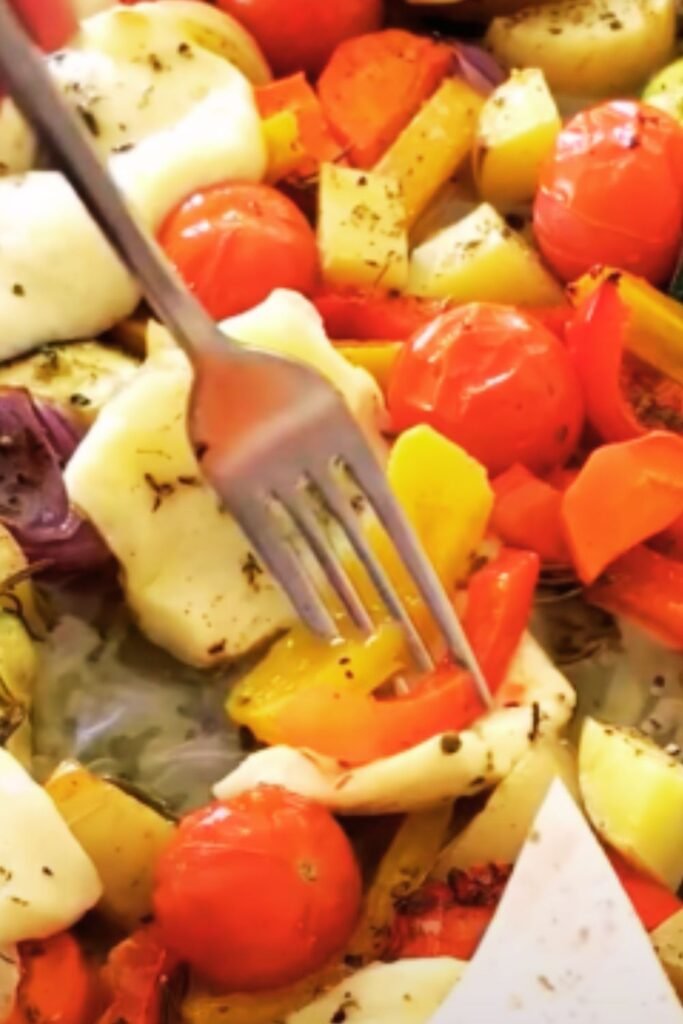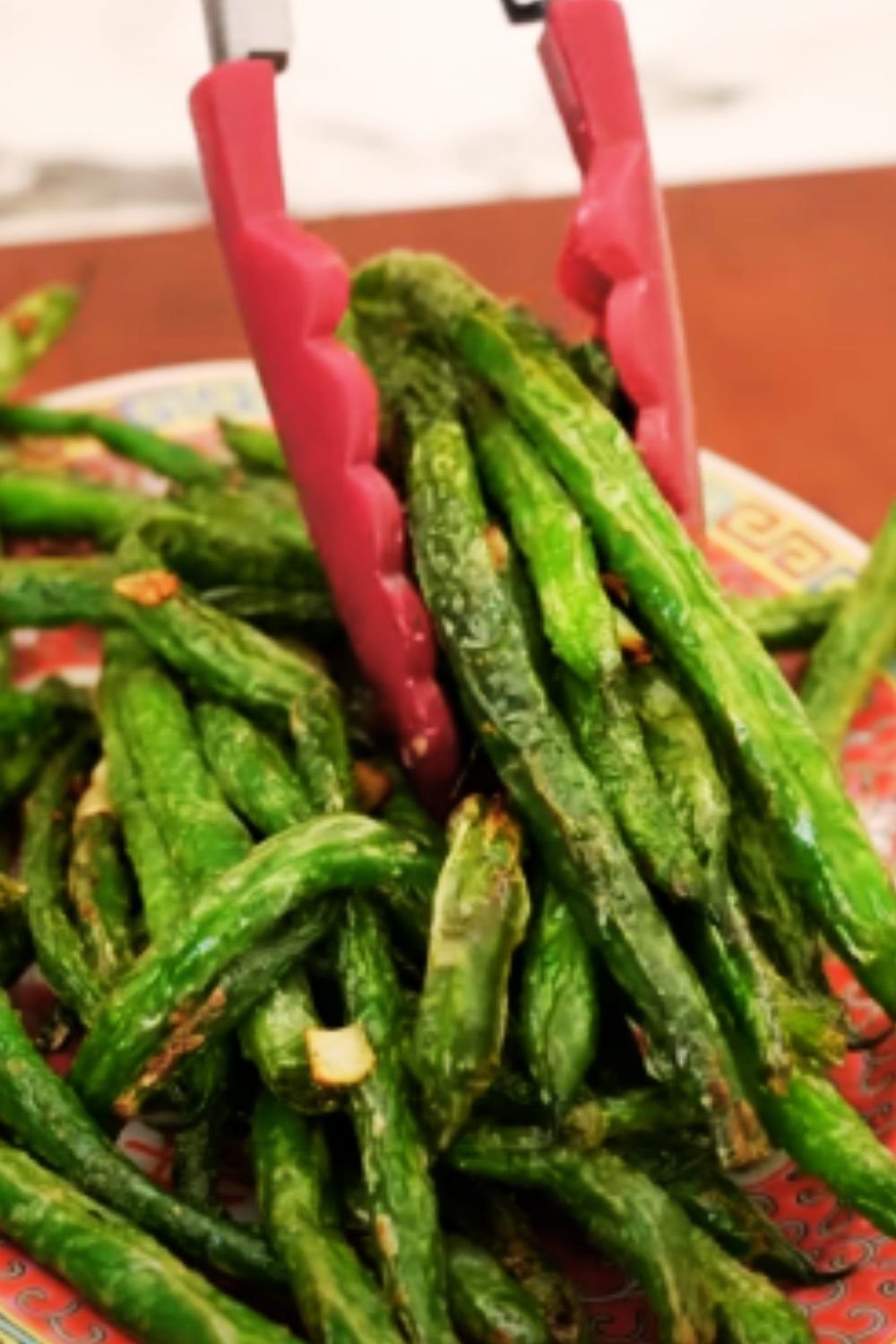There’s something magical about the combination of salty halloumi cheese and sweet roasted vegetables that transports me straight to a sun-drenched taverna overlooking the Mediterranean Sea. As someone who values both flavor and convenience, I’ve perfected this Halloumi and Mediterranean Veg Traybake over countless dinner parties and weeknight meals. It’s become my go-to recipe when I want to impress guests without spending hours in the kitchen.
What makes this dish so special is its beautiful simplicity. Everything cooks together on one tray, allowing the flavors to mingle and develop, while the halloumi transforms into golden, crispy-edged pieces of joy. I’m excited to share all my tips and tricks for making this dish absolutely perfect every time.
What Makes This Recipe Special
Before we dive into the specifics, let me tell you why this traybake deserves a permanent spot in your recipe collection:
- One-pan wonder: Minimal washing up and maximum flavor
- Versatile: Works as a main dish, side dish, or even as part of a mezze spread
- Customizable: Adapt the vegetables based on what’s in season
- Meal-prep friendly: Tastes amazing reheated the next day
- Visually stunning: The colors alone will make your mouth water
I’ve served this at everything from casual family dinners to sophisticated dinner parties, and it never fails to impress. The combination of textures and flavors feels indulgent yet wholesome at the same time.
Ingredient Spotlight: Getting to Know Halloumi
Halloumi is the undisputed star of this recipe, so let’s take a moment to appreciate this unique cheese:
Halloumi : A semi-hard, unripened cheese traditionally made from a mixture of goat’s and sheep’s milk, though cow’s milk is commonly used nowadays. Its high melting point allows it to be grilled or fried without losing its shape.
Origin : Originally from Cyprus, halloumi has been produced there for centuries and is now beloved worldwide.
Texture : When uncooked, halloumi is firm and squeaky. When grilled or roasted, it develops a beautiful golden crust while maintaining a soft, chewy interior.
Flavor profile : Distinctly salty with a mild tanginess. The flavor intensifies when cooked.
What makes halloumi perfect for this traybake is its ability to develop a beautiful golden crust in the oven while maintaining its shape. Unlike most cheeses that would melt into a puddle, halloumi stands proud among the vegetables, developing deep flavor as it cooks.
The Perfect Mediterranean Vegetable Selection
The beauty of Mediterranean cuisine lies in its celebration of fresh, seasonal produce. For this traybake, I’ve selected vegetables that not only taste delicious together but also cook at similar rates:
Red bell peppers : Sweet and slightly smoky when roasted, they add vibrant color and a hit of vitamin C.
Zucchini : Mild and versatile, zucchini absorbs the flavors of the herbs and olive oil beautifully.
Eggplant : The “meat” of the vegetable world, eggplant becomes silky and rich when roasted properly.
Red onions : They caramelize wonderfully in the oven, adding sweetness and depth.
Cherry tomatoes : These little flavor bombs burst during roasting, releasing their sweet juices that coat everything else.
While these are my go-to choices, the recipe is incredibly adaptable. In spring, I might add asparagus; in autumn, chunks of butternut squash work beautifully. The key is cutting everything to a size that will cook evenly.
Comprehensive Recipe Details
Let’s get down to the specifics of creating this Mediterranean masterpiece:
Ingredients
For the traybake:
- 250g halloumi cheese, cut into 1.5cm thick slices
- 2 medium zucchini, cut into thick half-moons
- 1 large eggplant, cut into 2cm chunks
- 2 red bell peppers, deseeded and cut into chunks
- 1 large red onion, cut into wedges
- 250g cherry tomatoes, left whole
- 4 cloves garlic, unpeeled but lightly crushed
- 3 tablespoons extra virgin olive oil
- 1 teaspoon dried oregano
- 1 teaspoon dried thyme
- 1/2 teaspoon smoked paprika
- 1/4 teaspoon chili flakes (optional)
- Sea salt and freshly ground black pepper
- 1 lemon, cut into wedges
For the herb dressing:
- 3 tablespoons extra virgin olive oil
- 1 tablespoon fresh lemon juice
- 2 tablespoons fresh parsley, finely chopped
- 1 tablespoon fresh mint, finely chopped
- 1 small garlic clove, very finely minced
- 1/2 teaspoon honey or maple syrup
- A pinch of salt and pepper
Equipment Needed
- Large rimmed baking sheet (approximately 40cm x 30cm)
- Parchment paper
- Sharp knife and cutting board
- Small bowl for mixing the dressing
- Measuring spoons
- Spatula for turning vegetables
Step-by-Step Instructions
- Preheat and prepare: Set your oven to 200°C (180°C fan/400°F/Gas 6). Line your baking sheet with parchment paper for easier cleanup.
- Vegetable prep: Prepare all your vegetables as described in the ingredients list. The key is to cut them into similar-sized pieces to ensure even cooking. I find that 2cm chunks work well for most vegetables.
- First roasting phase: Place the eggplant, zucchini, bell peppers, red onion, and garlic cloves on the prepared tray. Drizzle with olive oil, sprinkle with dried herbs, smoked paprika, chili flakes (if using), salt, and pepper. Toss everything with your hands to ensure each piece is coated. Spread out in a single layer, making sure not to overcrowd the tray.
- Initial bake: Place the tray in the preheated oven and roast for 20 minutes.
- Add tomatoes and halloumi: Remove the tray from the oven. Add the cherry tomatoes and slices of halloumi to the partially cooked vegetables. Drizzle the halloumi with a little more olive oil and sprinkle with a pinch more oregano.
- Final roasting: Return the tray to the oven for another 15-20 minutes, until the halloumi is golden and the vegetables are tender and slightly caramelized at the edges.
- Make the dressing: While the traybake finishes cooking, combine all the dressing ingredients in a small bowl and whisk together.
- Serve: Once done, remove the traybake from the oven. Squeeze over some fresh lemon juice, drizzle with the herb dressing, and scatter over some extra fresh herbs. Serve with lemon wedges on the side.

Pro Tips for Traybake Perfection
After making this dish countless times, I’ve gathered some invaluable insights that take it from good to exceptional:
Vegetable Preparation Techniques
- Eggplant: For the best texture, salt your eggplant chunks and let them sit for 30 minutes before rinsing and patting dry. This draws out any bitterness and helps them roast rather than steam.
- Zucchini: Don’t cut these too thin, or they’ll turn mushy. Half-moons about 1cm thick are perfect.
- Halloumi timing: Always add the halloumi partway through cooking. If you add it at the beginning, it will become too hard and rubbery.
- Garlic cloves: Leaving them unpeeled protects them from burning and allows them to steam inside their skins, creating a sweet, soft paste you can squeeze out.
Common Mistakes to Avoid
- Overcrowding the pan: This is perhaps the most common mistake. When vegetables are packed too tightly, they steam rather than roast. Use two trays if necessary.
- Cutting vegetables inconsistently: Take time to cut everything to a similar size to ensure even cooking.
- Under-seasoning: Vegetables need plenty of salt to bring out their flavor. Don’t be shy!
- Skipping the parchment paper: This not only makes cleanup easier but also prevents the halloumi from sticking to the tray.
Nutritional Profile and Health Benefits
This Mediterranean-inspired dish isn’t just delicious—it’s packed with nutritional goodness:
| Nutrient | Amount per serving | % Daily Value | Key Source in Recipe |
|---|---|---|---|
| Calories | 385 kcal | 19% | Halloumi, olive oil |
| Protein | 15g | 30% | Halloumi |
| Fat | 29g | 37% | Halloumi, olive oil |
| Carbohydrates | 18g | 7% | Vegetables |
| Fiber | 6g | 21% | Eggplant, zucchini |
| Vitamin C | 180mg | 200% | Bell peppers, tomatoes |
| Calcium | 450mg | 45% | Halloumi |
| Iron | 2.2mg | 12% | Vegetables |
| Potassium | 720mg | 15% | Eggplant, tomatoes |
| Antioxidants | High | – | All vegetables, herbs, olive oil |
*Based on a 2,000 calorie diet. Values are approximate.
The Mediterranean diet, which this recipe embodies, has been consistently ranked as one of the healthiest eating patterns globally. Rich in vegetables, healthy fats from olive oil, and moderate amounts of dairy, it’s associated with heart health, longevity, and reduced inflammation.
Serving Suggestions and Meal Pairings
This versatile traybake can stand alone as a main dish or complement other Mediterranean favorites:
As a Main Course
- Serve with warm pita bread or crusty sourdough to soak up the delicious juices
- Add a dollop of Greek yogurt mixed with a little crushed garlic and lemon zest
- Pair with a simple green salad dressed with lemon and olive oil
As a Side Dish
- Alongside grilled fish or chicken
- With herby couscous or quinoa
- As part of a larger mezze spread with hummus, baba ganoush, and olives

Variations to Try
Once you’ve mastered the basic recipe, try these delicious variations:
Seasonal Adaptations
Spring Version
- Add asparagus and spring onions
- Use fresh oregano and thyme instead of dried
- Include young, tender artichoke hearts
Summer Version
- Add corn cut from the cob
- Include slices of summer squash
- Top with plenty of fresh basil after cooking
Autumn Version
- Add chunks of butternut squash (pre-roast these for 10 minutes before adding other vegetables)
- Include a few sage leaves
- Add a handful of toasted pumpkin seeds before serving
Winter Version
- Include parsnips and carrots
- Add a sprinkle of za’atar seasoning
- Finish with pomegranate seeds for brightness
Dietary Adaptations
Vegan Option
- Replace halloumi with extra-firm tofu, pressed and marinated in olive oil, nutritional yeast, and salt
- Or try thick slices of pre-cooked polenta brushed with olive oil
Lower Sodium Version
- Use low-sodium halloumi or reduce the amount
- Enhance flavor with more herbs and lemon instead of salt
- Add a splash of balsamic vinegar before serving
Storage and Reheating Guidelines
One of the many reasons I love this dish is how well it works as leftovers:
Storage
- Refrigerate any leftovers in an airtight container for up to 3 days.
- The flavors actually develop overnight, making next-day leftovers particularly delicious.
Reheating
- Oven method (preferred): Reheat at 180°C for 10-15 minutes until warmed through. This helps maintain the texture of the vegetables and halloumi.
- Microwave method: Use for quick reheating, but be aware the halloumi will lose some of its crispness. 1-2 minutes on medium power is usually sufficient.
- Cold option: This dish is also delicious cold! Try leftovers as part of a grain bowl or on top of mixed greens for a satisfying lunch.
Troubleshooting Common Issues
Even experienced cooks encounter challenges. Here’s how to solve common problems with this recipe:
Vegetables turning out soggy instead of roasted
Problem: Your vegetables are steaming rather than roasting, resulting in a soggy texture.
Solution: Make sure your vegetables are thoroughly dried after washing, use a large enough baking sheet, don’t overcrowd the pan, and ensure your oven is fully preheated. For very watery vegetables like zucchini, consider salting and draining them first.
Halloumi too tough or rubbery
Problem: The halloumi has overcooked and become too chewy.
Solution: Add the halloumi later in the cooking process. If your oven runs hot, position the rack in the middle rather than near the top, or slightly reduce the cooking temperature.
Vegetables cooking unevenly
Problem: Some vegetables are overcooked while others remain undercooked.
Solution: Cut all vegetables to a similar size. For vegetables that generally cook faster (like zucchini), cut them slightly larger. For those that take longer (like eggplant), cut them a bit smaller.

The Cultural Heritage of Mediterranean Traybakes
I’ve always been fascinated by the way Mediterranean cooking embraces simplicity while delivering incredible flavor. This traybake is a modern interpretation of a cooking style that has existed for centuries across Greece, Cyprus, Turkey, and the Levant.
In traditional Mediterranean cooking, making the most of the oven was essential. Families would prepare trays of vegetables, sometimes with cheese or meat, to cook while bread was baking. This efficient use of heat created dishes that were both economical and delicious.
What I find most beautiful about this style of cooking is how it celebrates local, seasonal ingredients. Nothing is wasted, and simple preparations allow the quality of each component to shine.
Frequently Asked Questions
Q: Can I prepare any elements of this dish ahead of time?
A: Absolutely! You can chop all the vegetables up to a day in advance and store them in the refrigerator. I recommend keeping the eggplant in water with a squeeze of lemon juice to prevent browning. The herb dressing can also be made ahead and stored in the refrigerator for up to 2 days.
Q: How do I stop my halloumi from becoming too salty?
A: Unlike some traditional preparations, you don’t need to pre-soak the halloumi for this recipe. However, if you find your halloumi particularly salty, you can soak it in cold water for 10 minutes before patting it dry and adding it to the traybake.
Q: Can I freeze leftovers of this dish?
A: While you can freeze the roasted vegetables for up to 3 months, I don’t recommend freezing the halloumi as its texture will deteriorate. If you’re planning to freeze portions, consider adding freshly cooked halloumi when reheating the dish.
Q: Is there a way to make this dish even more substantial?
A: Yes! You can add chickpeas or cannellini beans during the last 10 minutes of cooking for extra protein and fiber. Alternatively, serve it over cooked farro, quinoa, or bulgur wheat for a heartier meal.
Q: How can I get my vegetables to caramelize better?
A: The key to good caramelization is high heat, low moisture, and enough space between vegetables. Make sure your oven is fully preheated, pat vegetables dry before roasting, and consider using two baking sheets if needed to avoid overcrowding.
Q: What’s the best substitute if I can’t find halloumi?
A: If halloumi is unavailable, try using paneer (though it won’t get as crispy), thick slices of feta (add these in the last 5 minutes only), or even slices of firm tofu that have been pressed and marinated in olive oil, nutritional yeast, and salt.
My Personal Connection to This Recipe
The first time I tasted halloumi was during a summer vacation on a small Greek island. I watched in amazement as the taverna owner threw thick slices directly onto a hot grill, where they sizzled and browned without melting away. Served with a simple salad of tomatoes, cucumbers, and herbs, that meal left an indelible impression.
Years later, trying to recreate those Mediterranean flavors in my much less sunny home kitchen, I developed this traybake. While it’s evolved over time, the essence remains the same: letting good ingredients speak for themselves with minimal intervention.
What I love most about sharing this recipe is seeing how others make it their own. Some friends add different herbs based on what’s growing in their gardens; others incorporate local vegetables I’d never considered. Each variation reinforces what makes Mediterranean cooking so special—its adaptability and celebration of what’s fresh and available.
So as you prepare this dish in your own kitchen, I encourage you to think of it as a template. Add your personal touch, adapt it to your tastes, and most importantly, share it with people you love. After all, that’s what Mediterranean food culture is all about—gathering around a table to enjoy simple, delicious food together.


